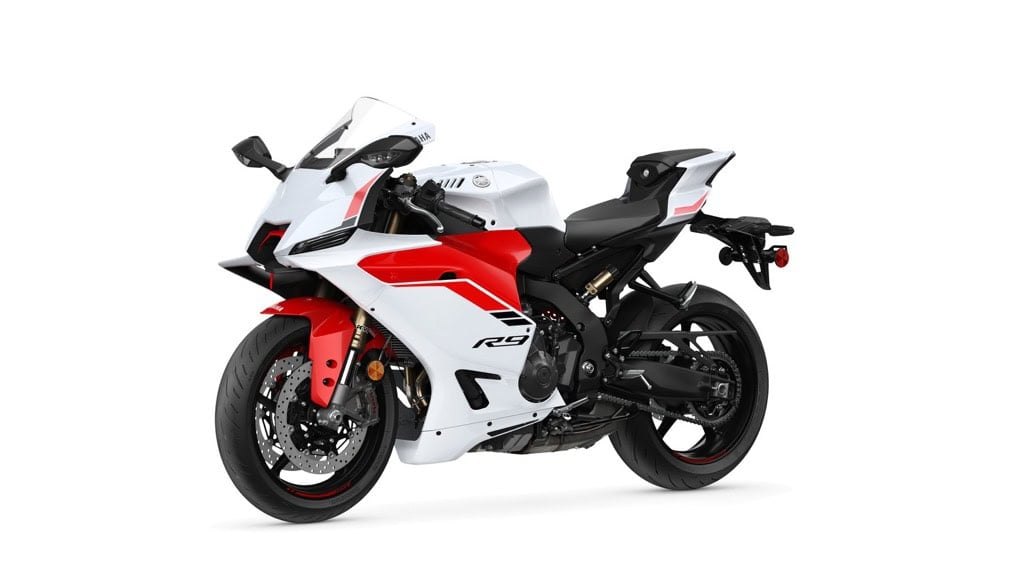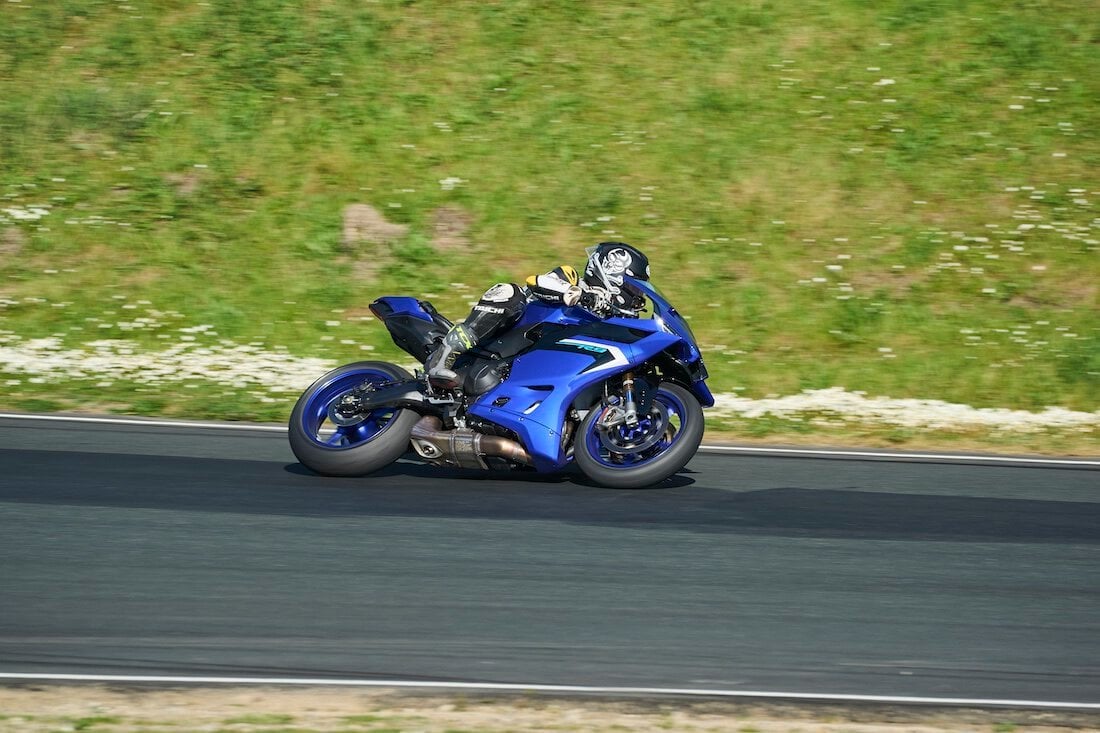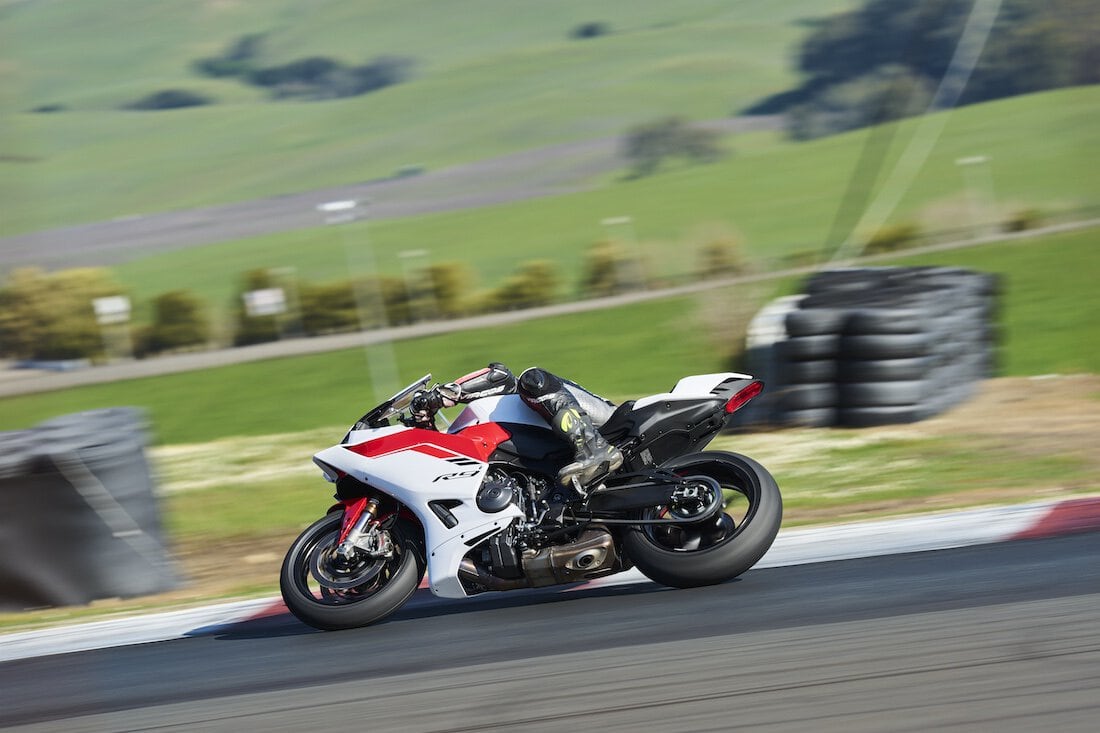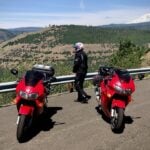Supersport Redefined
We all know the legendary status the Yamaha R6 has earned. The 2008-16 generation dominated the Supersport scene and has a gigantic following in the street sport bike community. This status continued on with the next generation release in 2017 until it was announced that the popular R6 would be discontinued in 2020. The next question on everyone’s mind was, what happens now? What would Yamaha do to take over that space in the Supersport lineup?
The most common rumor was a bike based around Yamaha’s popular CP3 triple cylinder engine found in likes of the MT-09, XSR900 and Tracer 9 GT. When it was revealed Yamaha had filed a patent for a bike model named “YZF-R9” back in 2021, the motorcycling world went mad with rumor and we’ve been waiting impatiently ever since. It was my “bucket list bike” for the new year, and Joshua Placa got a sneak peek last fall.
Now in 2025, we finally have the highly anticipated YZF-R9.
Last summer, I had my first experience with the CP3 engine when I attended the launch for the MT-09SP model. I have a special love for three cylinder engines and I thoroughly enjoyed my first experience with the triple from the Tuning Fork brand. The engine had good overall linear delivery, with just a slight dead spot in low rpms below 6k. While at the event I had pleaded with Yamaha’s Senior Street Motorcycle Communications Specialist Gerrad Capley to make sure whenever the R9 launches, the event is held at a racetrack.
Fast forward a few months and I happily found myself packing my track gear and jumping on a plane for sunny Sonoma, California for the official Yamaha R9 press event at Sonoma Raceway. With such anticipation and hype around the bike over the years and having recently watched the bike debut in World Supersport with a win, I was extremely excited for the opportunity to be one of the first people stateside to throw a leg over the bike.
My ride for the day. Hot.
The Technical
Over the past few years, I’m sure we’ve all heard the same rumblings when it comes to the R9. For those that haven’t, it went something like this- “It’s going to be the direct replacement for the R6 but I hope it isn’t just an MT-09 with fairings.” I’d be lying if I said those same thoughts hadn’t also crossed my mind, so I was eager to hear the story behind the bike and the decisions that were made in its design. When I beheld the first images of the R9, I rolled my eyes when I spotted the winglets. I’m a bit of a purist with motorcycles so I haven’t completely come around to the concept of F1-style tech finding its way to two-wheeled racing, let alone street bikes. However, when I saw the R9 in the flesh, I was impressed with how sharp it looked and how nicely the lines flowed, even around the winglets. They are noticeable but fit in with the flowing, aggressive lines of the bike. They don’t look unnecessary and add just enough to the aesthetic to tell you, this bike is something new and different.
The consensus amongst the journalists seemed shared, as we all felt the bike looked much better in person.
Sitting down to the media presentation the night before the ride, we were met by the Yamaha USA staff but also by several members from Yamaha corporate in Japan, including development staff, test riders and Kouji Tsuya. Not only is Tsuya-san the R9 project lead but he’s also a former Yamaha MotoGP project lead, and his time in the role includes Jorge Lorenzo’s 2016 MotoGP championship season. He has also worked with riders like Fabio Quartararo and Maverick Vinales. In addition to the Yamaha personnel, several techs from KYB suspension were on hand to give us insight on the all-new suspension components that are found on the R9.
The 2025 R9 colorways.
Yamaha USA Street Motorcycle Senior Product Planner Aaron Bast carefully explained the extensive research that the R9 was born from. One of the main reasons he explained is the correlation found between the new and used motorcycle market, especially when it comes to Supersport motorcycles. Research found when new bike sales plummeted during the 2008 financial crisis, used motorcycle sales have remained steady even through today. Coupled with the fact that buyers said price was the number one reason for not purchasing a Supersport bike, Yamaha recognized the need to make the segment more accessible. Cue the Yamaha YZF-R7, which began the redefining of the Supersport segment and is also, to-date, the best selling motorcycle for Yamaha in the United States.
“Extreme Performance” to “Accessible Performance”
The impressive sales gave Yamaha the further evidence it needed to move forward with its plan, which Aaron explained was to completely redefine what definition of “Supersport.” The traditional characteristic of this type of motorcycle has always been about “Extreme Performance.” Yet Yamaha is looking to rewrite that definition to be “Accessible Performance.” The R9 is the definition of this new way of thinking and Aaron was very clear to everyone, this is not an R6 replacement of all out performance at any cost. This is a new Supersport market that is all about accessible performance, balanced for the street and the track.
CP3 engine, subframe and swingarm.
As the presentation continued, we dove more into the technical aspects of the bike. The R9 centers around the popular CP3 engine which remains unchanged for the R9. The frame is all new from the ground up, with a new gravity cast design that is actually 10% lighter than the R6. The swingarm is derived from the MT-09 but has 16mm of increased adjustment range. One part that is a direct crossover from the MT-09 is the subframe. With the new chassis and modified swingarm design, Yamaha claims a perfect 50/50 weight distribution.
The bike comes standard with Bridgestone S22 tires on 5 spoke cast aluminum wheels, which Yamaha found through testing gave better contact feeling at lean angle when compared to the spin forged wheels from the MT-09, which are slightly lighter.
One of the biggest talking points was the the R9’s suspension. The KYB front and rear suspension is fully adjustable (including high and low speed compression) with a 43mm KYB SDF (Separate Damping Fork) fork setup with compression on the left and rebound on the right. The KYB reps explained the separated damping allows for better control when switching between the compression and rebound movement. The forks also include a base valve added on the rebound side which helps improve the response and eliminate dead spots in the stroke. This design was said to provide greater support under braking, on the street and track.
Brembo, KYB, and left side sub frame.
In the rear, the KYB shock includes a remote adjuster and a specially developed swing valve for compression and rebound, which is a first in any production motorcycle. For the suspension nerds among us, the swing valve is an additional pathway that oil must pass through which allows for more control at the top end of the compression and rebound stroke, eliminating lag at the transition point that can sometimes happen, especially on track while transitioning over bumps or onto the throttle.
For stopping power, the R9 has 320mm Brembo Stylema brakes mated to a stainless steel brake line on the front and ABS front and rear. I experienced the same setup on the MT-09SP minus the stainless steel line.
KYB remote rear adjuster; TFT display.
I won’t go into a deep dive on the electronics but the R9 includes a 5 inch TFT display, utilizing Yamaha’s 6-axis IMU (Inertial Measurement Unit) that supports the same tech found on other models (like my Yamaha R1), including traction control, slide control, lift management, engine brake management, clutchless up and down shifting, launch control and back slip regulation with a slipper clutch. In addition, the R9 has cruise control, and the ability to set a max speed with Variable Speed Control, connectivity through Y-Connect to enable navigation, weather, music, email, text and phone alerts and a last-parked location tracking option.
A feature-filled machine
Riders also have various ride modes (Sport, Street, Rain, Track, Custom) to choose from and the ability to customize them to suit individual preferences. For our time at Sonoma Raceway we would be in Track mode which also allows for the rear ABS to be switched off.
With all of this info in hand, there was only one thing left to do- get out and ride!
Oh yeah. Let’s ride this baby.
The Track
When we arrived at Sonoma, we were greeted by the Yamaha team as well as 4-time AMA Superbike champion Josh Hayes, who was on hand to help us learn the track and get the most out of the R9. As we sat in the briefing we were told the R9 can easily be swapped into GP shift and the rearset position can be changed one notch higher if needed. I immediately asked the staff to change my bike to GP shift, which took about two minutes, and involved simply moving the linkage to one of the two available attachment points on the shift lever, one fore and one aft of the pivot point.
We all piled into a van and Josh took us around the track telling us what lines to take and how to approach each corner. I rode Sonoma in 2020 on a Ninja 400 so I at least had a general idea of the track layout, but I had forgotten how much elevation change there was on track.
The R9 comes in three colors- Black, Yamaha Blue, or White & Red. We had a choice of the Yamaha Blue or the white/red scheme for the day. I had to go with the white and red colorway as it reminded me of the original 1998 Yamaha R1. All the bikes were equipped with Bridgestone R11 DOT race tires, a tire I raced on for many years, so I was content knowing grip would not be an issue.
After gearing up I hopped on the bike, gave a thumbs up to the staff as they removed my tire warmers and dropped me off the stands. I looked at the dash and the TFT display looked similar to my R1, just more updated with more vibrant color and some small changes to the layout.
Getting to know each other, and settling in.
As I rolled down pit lane I glanced down again quickly and noticed the bike was in power mode 2, so I would not have full power on tap, but given the colder morning temps, around 50F degrees, I was fine to have some early tameness in the engine. Rolling on the throttle my ears were greeted by the sweet 3-cylinder note and the nice steady linear pull of the engine. The bike had smooth shifts up and down through the gears and I was delighted at how light and nimble the bike felt. The brakes gave an immediate response, more than I expected, to the point I was finding myself with a lot of extra room to brake, almost needing to roll on the throttle before some corners.
My lack of braking was made completely transparent when I rolled out for a later session, this time with full power when Josh came up by me, tapped his tail and happily gave me “a tow” (meaning follow him, and mimic his lines). I caught myself smiling more than once telling myself, “I’m getting a tow from Josh Hayes!” For those that don’t know, Josh has long been a racing idol of mine and is even the reason for the number 4 in my ASRA 411 racing number.
Josh Hayes trailing me to offer some helpful tips, then showing how its done.
After the session we met in the pit garages and the first thing Josh said to me was, “You’ve got to get on the brakes more, man.” I half laughed, sheepishly replying, “I know I do.” I’ve raced lightweight bikes for so long my racer brain is all about light braking and corner speed. What Josh was saying by telling me to brake more was that I need to get better at braking hard, straight lining for the apex more and firing the bike out, especially if I want to make a competitive run at MotoAmerica on my R1. It’s a lesson I know I need to learn and that I’m still struggling to overcome. As the day went on I purposely pushed my brake markers, staying on the brakes harder and longer. I never found myself wishing I had more brakes, albeit I did notice some fade as the day wore on, but the bike still stopped whenever I needed.
Brake harder and longer
Pushing the pace in the afternoon also revealed to me one thing I was wondering when I thought about how nimble the bike felt, and that was stability. I was told Sonoma recently did a repave, but there are still some bumpy spots I recalled from my first experience in 2020. The chassis felt very stable over those sections and I was especially happy with how planted the bike felt through some of the faster right hand sweeping corners as well as the long downhill left hander of Turn 6. Other street bikes I have ridden on the track have left me wanting more, with much too soft of a stock setup which led to a quickly found grip limit or a constant feeling of vagueness. The KYB suspension provided very direct and useful feedback and in stock trim with no changes made, it’s in the ballpark of what I would want for a track setup. I made a couple of recommended changes from the Yamaha staff which involved taking out a click of front and rear rebound. Riding the next session, I could immediately feel the difference.
I am really feeling this bike. Love it.
I’m definitely on the sensitive side when it comes to adjustments but I was still surprised how much adjustment an OEM suspension could have and how good the feedback was. It honestly reminded me a lot of the race suspension I’ve used in the past on various bikes. My hats off to KYB on the development, as they gave the R9 a solid suspension setup. Having this from the factory is another check in the accessibility box Yamaha is looking for. I would not feel a need to put money into suspension upgrades if I were to take this bike out and do a trackday.
Later in the afternoon I was able to ride an R9 with the optional Y-Trac Rev system. This is similar to the Y-Trac system found on other models which includes the usual GPS data with mapping and data logging. However, this new system has one additional and very cool feature. It allows messages to be displayed directly on the dash, MotoGP style. Riders can have messages customized and sent directly to the dash while on track. During my session the Yamaha team sent me my name on the TFT display as well as “Take it easy” when I got my “box” call to come in. It was cool feeling like a MotoGP rider for a few laps! I could see this feature coming in handy for anyone doing endurance racing.
Sonoma Raceway is such a fantastic track. And this was the perfect bike for it.
As we wrapped up for the day, I realized I hadn’t thought about the ergonomics the entire time. Not because I forgot but because I felt comfortable right away, the overall ergonomics really acquitting itself well at the track. With the narrower seat and 0.8 lower height than the R6 I felt very at home on the bike. I’m 5’10” and around 180 lbs. with an athletic build. There was a range of statures among the journalists present and I did not hear any complaints about the ergonomics from anyone. If any did, they had the option to adjust the rearsets with that higher position if needed.
I had a quick word with Tsuya-san and asked him how long the R9 has been in development, and he told me four years. Thinking back to the presentation the night before, I contemplated how much work it must have taken to get to this point. I recalled earlier in the day when I saw Tsuya-san standing and watching us like a proud father anytime we left the garages to go on track. I really enjoyed hearing him talk about the project and how much pride he obviously took in the R9.
Just a few more laps, please!
Tsuya-san also informed me Yamaha experimented with over 200 different design configurations for the design shape of the bike, including those winglets. Yamaha claims the winglets are not just for show, but provide 10% greater downforce over 150 KPH/93 MPH and 6-7% better wheelie control. I couldn’t tell any noticeable difference on track, but it was interesting to hear how much development work was done.
Such a remarkable motorcycle.
Wow. What a day. What a motorcycle.
Yamaha set about making high performance more accessible, rewriting the definition of Supersport to give the segment longevity for the foreseeable future. After riding the YZF-R9 all day at Sonoma Raceway, I think Yamaha nailed their target. The bike fits perfectly between the R7 and R1 with the approachability of the R7 with the CP3 engine and lightweight chassis, but with the high end performance brakes, suspension and electronics that would be at home on the R1. Where this fits though, isn’t where the R6 was because this bike is something different.
Talking with Josh the night before, he told me he felt like the bike had a different character than any other Yamaha he’d ridden and I have to agree. I don’t look at it as filling the shadow of the R6, because it’s not meant to be what the R6 was. This is a bike that can give you performance but not with the caveat of “Once I can figure out how to get it out of the bike.” You just need to have the desire to ride and have fun with it.
Changing how riders look at a segment as a whole is no easy task, especially the long-popular Supersport market. However, I think Yamaha has given us a new lens to look through with the R9. Thanks to Yamaha for having me out to look through that lens at the future. It’s looking to be a good one.
Ryan “Ryhno 411” Nolan
(All photos and footage by Yamaha Motors USA & Spec PR)
For more on the R9, check out Yamaha’s page:
YZF-R9
*Check out our official ride review video!













































0 Comments